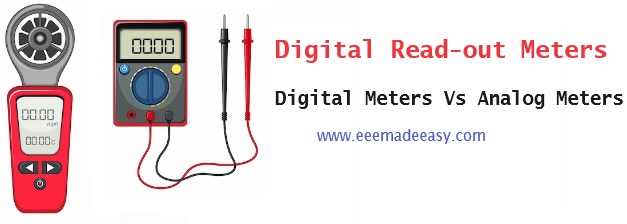Digital Meters: Increasingly, metering devices are being designed so that they provide a direct readout, and there’s no need (or possibility) for interpolation. The number on the meter is the indication.It’s that simple. Such a meter is called a digital meter.
Download & Install EEE Made Easy App
Advantages of Digital Meters
The advantage of a digital meter is that it’s easy for anybody to read, and there is no chance for interpolation errors.
This is ideal for utility meters, clocks, and so me kinds of ammeters, voltmeters and wattmeters. It works very well when the value of the quantity does not change very often or very fast.
Read : Types of Errors in Instruments| Instrument Errors
But there are some situations in which a digital meter is a disadvantage. One good example is the signal-strength indicator in a radio receiver.
This meter bounces up and down as signals fade, or as you tune the radio, or sometimes even as the signal modulates.
A digital meter would show nothing but a constantly changing, meaningless set of numerals.
Digital meters require a certain length of time to “lock in” to the current, voltage, power or other quantity being measured.
If this quantity never settles at any one value for a long enough time, the meter can never lock-in.
Meters with a scale and pointer are known as analog meters.
Their main advantages are that they allow interpolation, they give the operator a sense of the quantity relative to other possible values, and they follow along when a quantity changes.
Some engineers and technicians prefer the “feel”of an analog meter, even in situations where a digital meter would work just as well.
Also Check:
Digital Multimeter Tester Smart Voltmeter for Electrical Testing
Themisto TH-M98 Digital Multimeter
Themisto TH-M88 True RMS Digital Clamp Meter
Disadvantages of Digital Meters
One problem you might have with digital meters is being certain of where the decimal point goes. If you’re off by one decimal place, the error will be by a factor of 10.
Also, you need to be sure you know what the units are; for example, a frequency indicator might be reading out in megahertz, and you might forget and think it is giving you a reading in kilohertz.
That’s a mistake by a factor of 1000.
Of course this latter type of error can happen with an analog meter, too.
Also Read
- [PDF]Electrical Measurements Measuring Instruments Study Notes PDF|EMMI Notes EEE Made Easy
- MCQ on Electrical Instruments
- Types of Errors in Instruments| Instrument Errors
- MCQ’s on Electrical Measuring Instruments|Instruments Objective Questions
- Electrical measuring instruments|Types of Measuring Instruments
- Static characteristics of instruments
- Types of measuring instruments- www.eeemadeeasy.com
- Moving Iron Instruments
- Instruments- Basics
- PMMC Instruments
- Types of instruments
- Essentials of Indicating instruments
- MCQ’s on Galvanometer|Galavnometer Questions & Answers
- MCQs on potentiometer|potentiometer Questions and answers
- TOD Meter or Time of Day Meter
- Light meters or illumination meter|Lux meter
- VU and decibel meters
- Multimeter- Principle and operation
- Digital readout meters-principle and operation
- Watt-hour meters- principle and operation
- Wattmeter -principle and working
- FET and vacuum-tube voltmeters
- Ohmmeter- basic principle and working
- Ammeters|Current Measurement
- Voltmeter- Principle and operation
- The household energy meter is
- Q Meter
- Industries Extension Officer Syllabus Kerala PSC|IEO 2024 Syllabus
- [PDF]Trade Instructor Gr.II Electroplating Syllabus Kerala PSC|92/2023 syllabus
- [PDF] Syllabus Assistant Engineer Electrical Harbour Engineering Kerala PSC
- Industries Extension Officer Kerala PSC Notification|IEO 2024
- Electricity Act 2003 Section 135
- Synchronous Motor Advantages, Disadvantages & Applications
- [Latest]Assistant Director industries and commerce Kerala PSC syllabus|630/2023 syllabus







